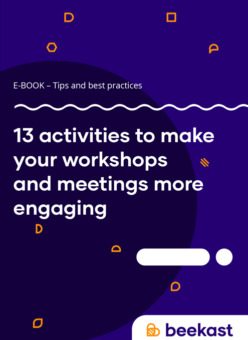Video tutorials, webinars, MOOCs, live streams… and so on. The possibilities to get your message across are endless. But nothing can quite replace the physical presence of a speaker on stage. Read on to discover five methods for a killer presentation using the most powerful tool at your disposal: you!
When certain speakers take the stage, their audiences seem hypnotized, hanging on to their every word. Without PowerPoint presentations or any other kind of visual illustration, their enthusiasm alone suffices to monopolize all attention. That’s the stuff any speaker’s dreams are made of! However, does that mean that a meticulously prepared PowerPoint presentation is completely useless? To be clear from the start: A presentation is only ever meant to complete your talk and never to replace it. With that in mind, let’s have a closer look at how to boost your charisma and get the most out of your presentation.
1. Use your eyes
Making eye contact is the top tool of the speaker to captivate his audience. Have you ever sat in a conference and felt as if the speaker was directly talking to you? If so, chances are, your neighbor had the exact same impression. The most talented speakers are capable of making every single member of their audience feel seen and directly concerned.
How is that achieved? The speaker’s eyes are constantly scanning the room, resting for an instance or so on different faces in the audience. By the end of his talk, everyone feels personally impelled. Obviously, that is a lot easier done with small audiences. However, even larger audiences can feel more involved if you take the time to scan different segments and turn into all directions.
Another method consists of raising your eyebrows slightly higher than you naturally would once you enter the stage. As bizarre as this may seem, research has shown that widening your gaze immediately creates a feeling of complicity and trust toward you.
Don’t forget to Use Body Language to Rock Your Next Presentation (Stanford Graduate School of Business).
2. Master your flow
The goal is usually not to squeeze as many words as possible into a minimum amount of time. Don’t let stress take over and rush you through the talk. Speak calmly and use breaks to mark crucial points just like a skillful storyteller. Your talk should neither be a rapid succession of words nor a slow dispersion of bits and pieces. Vary your rhythm to keep the suspense going.
3. Smile
Everybody knows that smiling is much more likely to inspire trust than a serious face – in most cases at least. However, the power a smile holds for the person smiling is often neglected: smiling will build confidence not only on the side of your audience but also in yourself. You are more relaxed, less stressed and ready to add a pinch of humor. What could be better to shoo away stage fright? To top it off, your audience will feel more compassionate and gracious toward a smiling speaker. However, do not confuse a fake smile with a genuine expression of happiness. A grimace of tense muscles and teeth, the forced smile of models in magazines, has little to offer on stage. In that case, forget about the benefits for your self-confidence.
How to spot a fake smile
A genuine smile comes straight from the heart and is the expression of a certain mindset. To be able to conjure up the desire to smile you need to approach your audience with empathy and excitement: The will to share and communicate shows. Simultaneously, you will have to trust in your audience’s indulgence and curiosity.
4. Let your body talk
Your body does a lot of the talking on stage before you even open your mouth. In fact, your body language is the most accessible expression of your talk. Take an open stance, keep your body upright and include wide gestures. Like an actor, make use of the space you have. For example, move toward the audience when underlining a certain point and then take a few steps back to contemplate the situation or switch to another topic. Similarly, pay attention to your breathing to improve your posture and calm your voice.
5. Interact with your presentation
For a remarkable talk, you need to work your gaze, smile, pace your speech and develop your gestures. Your PowerPoint presentation is not the most important element of your performance. You have probably sat through a whole bunch of presentations but can you cite a single slide that left a lasting impression? Probably not. What counts is not how skillfully designed a presentation is but how the speaker interacts with his slides.
An excellent talk is characterized by a presentation that would be incomprehensive without the speaker’s explanations and comments. The role of your slides is to intrigue, to spark interest and to underline your boldest statements. Their full potential lies in your hands and depends entirely on your capacity to interact and play with them.
Here, the key to success is practice! Practice, practice, practice for however long it takes to feel perfectly at ease. According to Brent Schlender and Rick Tetzeli, the authors of Becoming Steve Jobs, it is due to relentless practice that Apple’s founder became an exceptional speaker.
No matter how sophisticated, your presentation by itself will not produce any miracles. It is entirely up to the speaker to bring his passion to the stage and only then, PowerPoint or other types of support media can do their jobs. The combination of both (presentation medium and talk) ensures an unforgettable experience for the audience as well as for you.
Find out how Beekast can help you create a memorable talk for your events!

